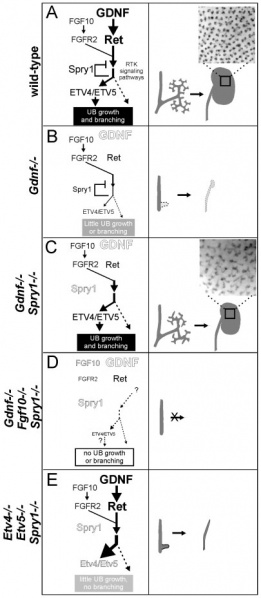File:Mouse-kidney model GDNF-FGF10.jpg

Original file (405 × 928 pixels, file size: 59 KB, MIME type: image/jpeg)
Mouse Kidney Model
Model: GDNF and FGF10 cooperate to promote ureteric bud branching morphogenesis, via Etv4 and Etv5, while Sprouty1 regulates signaling downstream of both RET and FGFR2.
(A) In wild-type, GDNF/RET signaling plays a major role and FGF10/FGFR2 a minor role in promoting UB outgrowth and branching morphogenesis. The response to these signals is modulated by SPRY1, leading to a normal kidney at birth (right panel). The transcription factors ETV4 and ETV5 are downstream effectors of GDNF and FGF10 signaling.
(B) In the absence of GDNF, there is presumably less SPRY1 produced [17] (indicated by smaller text), but FGF10 is insufficient to overcome negative regulation by SPRY1, causing reduced downstream signaling to induce UB budding and branching (indicated by thinner arrows), one manifestation of which is a severe reduction in Etv4/Etv5 expression [8]. Consequently, renal agenesis or severe hypodysplasia is observed.
(C) When GDNF and SPRY1 are both absent, the lack of negative regulation of signaling by FGFR2 allows for Etv4/Etv5 expression, UB branching, and kidney development; however, the pattern of UB branching is altered, suggesting a unique role of GDNF in this process.
(D) When FGF10 and GDNF are both absent, there is too little RTK signaling, even in the absence of negative regulation by SPRY1, to allow UB outgrowth from the Wolffian duct, resulting in renal agenesis (whether Etv4/Etv5 would be expressed is not known, as there is no ureter or kidney to analyze).
(E) Renal agenesis in Etv4−/−;Etv5−/− mice is not rescued by loss of Spry1, showing that increased RTK signaling is insufficient for kidney development in the absence of Etv4 and Etv5 (dashed arrow). The observation that ureters develop in Etv4;Etv5;Spry1 triple mutants suggests that UB outgrowth, but not later branching, can occur independently of Etv4/Etv5. Insets in a and c show the pattern of branching UB tips in stage P0 wild-type and double mutant kidneys.
Kidney development in the absence of Gdnf and Spry1 requires Fgf10. Michos O, Cebrian C, Hyink D, Grieshammer U, Williams L, D'Agati V, Licht JD, Martin GR, Costantini F. PLoS Genet. 2010 Jan 15;6(1):e1000809. PMID: 20084103 | PMC2797609 | PLoS
Reference
Citation: Michos O, Cebrian C, Hyink D, Grieshammer U, Williams L, et al. (2010) Kidney Development in the Absence of Gdnf and Spry1 Requires Fgf10. PLoS Genet 6(1): e1000809. doi:10.1371/journal.pgen.1000809
Editor: David R. Beier, Harvard Medical School, United States of America
Received: October 20, 2009; Accepted: December 10, 2009; Published: January 15, 2010
Copyright: © 2010 Michos et al. This is an open-access article distributed under the terms of the Creative Commons Attribution License, which permits unrestricted use, distribution, and reproduction in any medium, provided the original author and source are credited.
File history
Click on a date/time to view the file as it appeared at that time.
| Date/Time | Thumbnail | Dimensions | User | Comment | |
|---|---|---|---|---|---|
| current | 19:37, 26 April 2010 |  | 405 × 928 (59 KB) | S8600021 (talk | contribs) | Model: GDNF and FGF10 cooperate to promote ureteric bud branching morphogenesis, via Etv4 and Etv5, while Sprouty1 regulates signaling downstream of both RET and FGFR2. (A) In wild-type, GDNF/RET signaling plays a major role and FGF10/FGFR2 a minor role |
You cannot overwrite this file.
File usage
There are no pages that use this file.